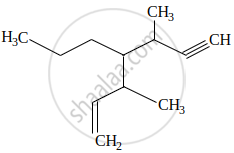Advertisements
Advertisements
प्रश्न
Phytane is a naturally occurring alkane produced by the alga spirogyra and is a constituent of petroleum. The IUPAC name for phytane is 2,6,10,14-tetramethylhexadecane. Write a zig-zag formula for phytane. How many primary, secondary, tertiary, and quaternary carbons are present in this molecule?
उत्तर
Zig-zag formula of phytane (2,6,10,14-tetramethylhexadecane) is as follows:

2,6,10,14-tetramethylhexadecane
Dash formula to represent types of C-atom:

In phytane, six 1° C-atoms, ten 2° C-atoms, four 3° C-atoms are present. Phytane does not contain any quaternary carbon atom in its structure.
APPEARS IN
संबंधित प्रश्न
Find out all the functional groups present in the following polyfunctional compound.
Dopamine a neurotransmitter that is deficient in Parkinson's disease.

Write IUPAC names of the following.

Write the IUPAC name of the following.

Write the IUPAC name of the following.

Write the IUPAC name of the following.

Observe the following and answer the questions given below:
\[\ce{CH3 - CH3 ->[U.V. light] \overset{\bullet}{C}H3 + \overset{\bullet}{C}H3}\]
- Name the reactive intermediate produced.
- Indicate the movement of electrons by a suitable arrow to produce this intermediate.
- Comment on the stability of this intermediate produced.
IUPAC name of \[\begin{array}{cc}
\phantom{....}\ce{H}\phantom{...}\ce{C4H9}\\
|\phantom{....}|\\\ce{CH3 - C - C - CH3}\\
|\phantom{....}|\\\phantom{.....}\ce{C2H5}\phantom{.}\ce{CH3}\phantom{...}\end{array}\] is
The IUPAC name of \[\begin{array}{cc}
\phantom{.}\ce{CH3}\\|\phantom{..}\\
\ce{H3C - C - CH = C(CH3)2}\\
|\phantom{..}\\\phantom{..}\ce{CH3}
\end{array}\] is
What is meant by a functional group?
Give the IUPAC names of the following compound.
\[\begin{array}{cc}
\ce{CH3 - CH - CH - CH3}\\
\phantom{...}|\phantom{......}|\phantom{.....}\\
\ce{CH3}\phantom{...}\ce{Br}\phantom{.}
\end{array}\]
Give the IUPAC names of the following compound.
\[\begin{array}{cc}\ce{CH3 - CH2 - CH - CHO}\\
\phantom{.....}|\\\phantom{.......}\ce{OH}
\end{array}\]
Give the IUPAC names of the following compound.

Give the IUPAC names of the following compound.

Give the structure for the following compound.
1,3,5- Trimethyl cyclohex - 1 -ene
Give the structure for the following compound.
3 - Chlorobutanal
Give the structure for the following compound.
3 - Chlorobutanol
Give the structure for the following compound.
2 - Chloro - 2- methyl propane
Give the structure for the following compound.
Butan - 2, 2 - diol
Give the structure for the following compound.
3-Chlorobut - 1 - ene
Give the structure for the following compound.
3 - methylbutan - 2 - ol
Which among the following carbocation is most reactive?
As per IUPAC nomenclature, the name of the complex [Fe(H2O)5(NCS)]2+ is ____________.
What is the IUPAC name of the following compound?
\[\begin{array}{cc}
\ce{CH3 - CH - CH - CH2 - CH - CH2 - CH2 - CH3}\\
\phantom{}|\phantom{.....}|\phantom{.............}|\phantom{...............}\\
\phantom{}\ce{CH3}\phantom{.}\ce{CH3}\phantom{..........}\ce{C2H5}\phantom{...........}
\end{array}\]
An organic compound on treatment with concentrated NaOH gave 2, 2-dimethylpropan-1-ol and sodium salt of 2, 2-dimethylpropanoic acid. The compound is:
In the reaction, \[\ce{Anisole + {'A'} ->[Anhydrous][AlCl3] 4-Methoxyacetophenone}\]
'A' is ____________.
What is a common name of the compound 1-Chloro-2, 2-dimethylpropane?
The IUPAC name for the following compound is:

Which one of the following reactions is expected to readily give a hydrocarbon product in good yields?
Consider the following reactions.
\[\ce{C6H5N^+_2Cl- ->[HBF4] A ->[NaNO2/Cu] B ->[Sn/HCl] C}\]
Identify the compound formed C in the above reaction.
